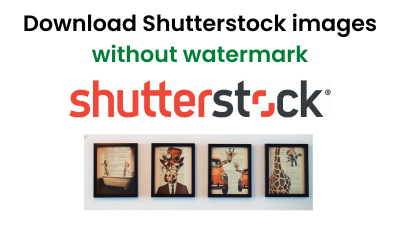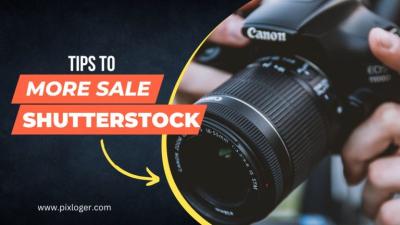If you’ve ever used an image from Shutterstock, you know how important it is to give proper credit. Crediting images isn’t just about being polite — it’s about respecting the creators’ rights and staying compliant with licensing agreements. Whether you’re a blogger, marketer, or small business owner, understanding how to correctly credit Shutterstock images ensures you’re legally protected and maintaining good ethical standards. In this guide, we’ll walk through the essentials of crediting
Understanding Shutterstock Licensing and Usage Rights

Before you start using Shutterstock images, it’s crucial to understand the different types of licenses and what they permit. Shutterstock offers mainly two types of licenses: Standard License and Enhanced License. Each comes with its own set of rights and restrictions, so knowing the difference can help you avoid any legal hiccups.
Standard License
The Standard License is ideal for most common uses — websites, social media, blogs, presentations, and printed materials with a limited audience. It allows you to:
- Use the image for digital or print projects up to 500,000 copies or views.
- Include the image in marketing materials, blogs, social posts, and online content.
However, there are some restrictions. You can’t use the image in merchandise that’s sold directly (like T-shirts or mugs), or in templates meant for resale. Also, if your project exceeds the license limits, you’ll need to upgrade to an Enhanced License.
Enhanced License
The Enhanced License is suitable for high-volume uses, merchandise, or projects that require broader rights. It allows for:
- Unlimited copies and views.
- Use in products for resale, such as apparel, packaging, or merchandise.
- More extensive distribution rights.
In short, if you’re planning to sell products featuring Shutterstock images or expect a large audience, an Enhanced License is the way to go.
Why Licensing Matters for Crediting
Understanding your license type isn’t just about legal compliance — it directly influences how you should credit images. While some licenses might require explicit attribution, others might not, especially if you purchase an extended license or use images in specific ways. Always review the license agreement associated with each image to see if attribution is mandatory, and follow the guidelines carefully to avoid potential copyright issues.
Steps to Properly Credit Shutterstock Images
Crediting Shutterstock images the right way might seem a bit tricky at first, but once you get the hang of it, it becomes second nature. The key is to ensure you’re giving proper attribution to respect the creator’s rights and stay compliant with Shutterstock’s licensing terms. Here’s a simple step-by-step guide to help you do just that:
Step 1: Check the License Type
Before anything else, verify the license of the image you’re using. Shutterstock offers different licensing options—standard and enhanced. Most stock images used for blogs and websites are covered under the standard license, which typically requires attribution if specified. Always read the licensing details to see if attribution is necessary or recommended.
Step 2: Identify the Creator and Image Details
Look for the photographer or artist’s name associated with the image. Usually, this info is available in your Shutterstock account under the image details or on the image download page. Make note of the image’s title, the creator’s name, and the Shutterstock image ID or URL.
Step 3: Write the Attribution Properly
A good attribution should include the creator’s name, the source, and sometimes the license type. Keep it clear and concise. For example:
- Photo by John Doe / Shutterstock
- Image titled “City Skyline” by Jane Smith / Shutterstock
Step 4: Place the Credit Where It’s Visible
Typically, credits are placed directly below the image, at the bottom of the page, or in a dedicated credits section. Make sure it’s visible and legible without cluttering your content.
Step 5: Use Proper Formatting
Keep your attribution neat and consistent. You can use italics, bold, or normal text, but consistency helps maintain a professional look. For online content, a simple attribution line like “Image by Jane Doe / Shutterstock” works well.
Step 6: Keep Records of Licenses and Credits
For your own record-keeping, save screenshots of license details and attribution info. This can help if you ever need to prove proper crediting or clarify licensing questions later.
Examples of Correct Shutterstock Image Credits
To make it easier to see how proper attribution looks in practice, here are some examples you can adapt for your content:
Example 1: Simple Credit Below the Image
Photo by John Doe / Shutterstock
Example 2: Including Image Title and Creator
“Sunset over Mountains” by Jane Smith / Shutterstock
Example 3: Credit in a Footer or Credits Section
| Image Description | Credit |
|---|---|
| City Skyline at Night | Photo by Alex Johnson / Shutterstock |
| Flower Field | Image titled “Spring Blooms” by Emma Lee / Shutterstock |
Example 4: Combining Multiple Details
Image titled “Beach Sunset” by Michael Brown / Shutterstock
Remember, the goal is to acknowledge the creator clearly and accurately. Proper attribution not only shows respect for the artists but also keeps you compliant with licensing requirements. With these tips and examples, crediting Shutterstock images will become a straightforward part of your content creation process.
Common Mistakes to Avoid When Crediting Shutterstock Images
Crediting Shutterstock images might seem straightforward at first, but there are some common pitfalls that can trip you up if you’re not careful. Let’s go through some of these mistakes so you can steer clear and keep everything above board.
1. Forgetting to include a credit at all
This is one of the biggest errors. Even if the image is free to use, giving proper credit is a sign of respect for the creator and a legal requirement in many cases. Skipping this step can lead to copyright issues.
2. Using incorrect attribution details
Every Shutterstock image has specific attribution info—such as the photographer’s name and Shutterstock. Using outdated or incorrect details can cause confusion and might even violate licensing terms. Always double-check the attribution provided with the image.
3. Placing the credit in an inaccessible place
Make sure your image credit is visible and easy to find—near the image, caption, or in an acknowledgments section. Hiding it in fine print or in a footer might technically be acceptable in some cases, but it’s not good practice and can be considered disrespectful or non-compliant.
4. Ignoring the specifics of licensing agreements
Not all Shutterstock images are the same. Some require attribution, while others don’t. Read the licensing terms carefully. If attribution is needed, follow the exact format specified.
5. Failing to update credits after edits
If you modify an image—crop, add overlays, or change colors—make sure your credit still accurately reflects the original creator and source. Some licenses require that attribution remains consistent regardless of edits.
Remember, giving proper credit isn’t just about avoiding legal trouble; it’s about respecting the work of talented photographers and artists who share their creations with the world. Being diligent with your credits shows professionalism and appreciation.
Additional Tips for Using Shutterstock Images Legally and Ethically
Navigating the world of stock images can be tricky, but a few extra tips can help ensure you stay within legal and ethical boundaries while making the most of Shutterstock’s vast library.
- Always read the license agreement: Whether you’re using an image for a blog, a presentation, or a commercial project, take the time to understand the licensing terms. This helps you avoid unintended violations.
- Use images within the scope of your license: For example, if you have a standard license, don’t use the image in a way that’s restricted under an extended license, like in product packaging or merchandise.
- Keep records of your licenses and attributions: Save copies of purchase receipts and attribution details. This is especially helpful if questions about your usage ever come up later.
- Respect model and property releases: Some images feature recognizable people, private properties, or trademarks. Ensure that the necessary releases are in place for your intended use, especially for commercial projects.
- Avoid overusing the same images: Using the same Shutterstock image repeatedly across multiple projects can diminish its impact and might raise questions about originality. Mix up your visuals to keep your content fresh and ethically sourced.
- Credit appropriately when required: Even if not mandatory, giving credit to Shutterstock and the photographer demonstrates good ethical practice and supports the creators.
- Stay updated on Shutterstock policies: Stock image licensing rules can change. Regularly review Shutterstock’s terms and guidelines to stay compliant.
By following these tips, you’ll not only stay within legal boundaries but also foster a respectful and ethical relationship with content creators. Remember, stock images are a shared resource—using them responsibly benefits everyone involved and helps maintain a vibrant creative community.


